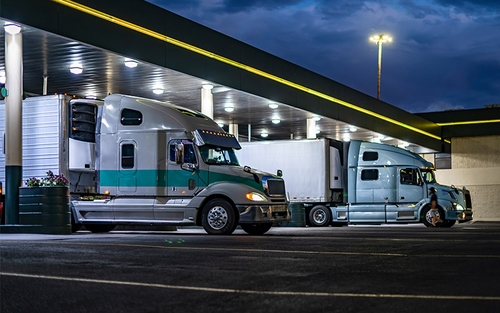How to calculate cost per mile as an owner-operator
October 30, 2023

Estimated reading time: 4 minutes
Part of being an owner-operator and running a successful business is knowing how to calculate cost per mile.
An easy way to determine your cost per mile is to create a trucking expenses spreadsheet. You can use the spreadsheet to keep track of your operating expenses, which are split into both fixed costs and variable costs.
Cost per mile formula
To calculate your cost per mile, divide your total expenses for the month by the total number of miles you drove that month.
For example, if your expenses totaled $3,000 and you drove 10,000 miles, your cost per mile would be $0.30.
4-step cost per mile calculation
1. Determine your fixed costs.
When you put together your trucking expenses spreadsheet to calculate your cost per mile, start by creating a column for all your fixed costs. Fixed costs are expenses that do not change from month to month regardless of how many miles you drive or how many loads you haul.
If you have expenses you pay every year, divide the total number by 12 and add it to each month’s fixed costs total.
See below for an example of what a fixed costs column could look like:
|
Fixed costs |
Monthly amount |
|
Truck payment |
$4,980 |
|
Insurance total (occupational accident insurance + unladen/non-trucking bobtail insurance + physical damage insurance + etc.) |
$690 |
|
License plates (including IRP certification) |
$154 |
|
Permits (things like a pre-pass) |
$25 |
|
Total fixed costs |
$5,849 |
2. Determine your variable costs.
Next, add a column to your spreadsheet for variable costs. Variable costs are expenses that change each month based on how much you drive and how many loads you haul.
It would not make sense for any of your variable costs to be yearly expenses, so you don’t need to divide any numbers by 12.
See below for an example of what a variable costs column could look like:
|
Variable costs |
Monthly amount |
|
Fuel |
$2,908 |
|
Food |
$350 |
|
Freight-related costs (freight brokers, dispatching services, load board fees, etc.) |
$2,000 |
|
Truck maintenance (repairs, tires, etc.) |
$628 |
|
Any other miscellaneous expenses |
$200 |
|
Total variable costs |
$6,086 |
3. Determine how many miles you drove.
Now, go back and figure out exactly how many miles you drove last month. Your total miles should include both compensated miles and miles that were not compensated (deadhead miles).
For the sake of this example, we are going to say you drove a total of 10,000 miles last month.
The sample spreadsheet now looks like this:
Fixed costs:
|
Fixed costs |
Monthly amount |
|
Truck payment |
$4,980 |
|
Insurance total (occupational accident insurance + unladen/non-trucking bobtail insurance + physical damage insurance + etc.) |
$690 |
|
License plates (and IRP certification) |
$154 |
|
Permits (things like a pre-pass) |
$25 |
|
Total fixed costs |
$5,849 |
|
Total miles driven |
10,000 |
Variable costs:
|
Variable costs |
Monthly amount |
|
Fuel |
$2,908 |
|
Food |
$350 |
|
Freight costs (freight broker, dispatching service, load board fees, etc.) |
$2,000 |
|
Semi-truck maintenance (repairs, tires, etc.) |
$628 |
|
Any other miscellaneous expenses |
$200 |
|
Total variable costs |
$6,086 |
|
Total miles driven |
10,000 |
4. Calculate your cost per mile.
Now you can calculate your cost per mile. To do this, divide your variable costs by your total miles driven and your fixed costs by your total miles driven.
The sample spreadsheet now looks like this:
Fixed costs:
|
Fixed costs |
Monthly amount |
|
Truck payment |
$4,980 |
|
Insurance total (occupational accident insurance + unladen/non-trucking bobtail insurance + physical damage insurance + etc.) |
$690 |
|
License plates (and IRP certification) |
$154 |
|
Permits (things like a pre-pass) |
$25 |
|
Total fixed costs |
$5,849 |
|
Total miles driven |
10,000 |
|
Fixed costs per mile |
$0.59 |
Variable costs:
|
Variable costs |
Monthly amount |
|
Fuel |
$2,908 |
|
Food |
$350 |
|
Freight costs (freight broker, dispatching service, load board fees, etc.) |
$2,000 |
|
Truck maintenance (repairs, tires, etc.) |
$628 |
|
Any other miscellaneous expenses |
$200 |
|
Total variable costs |
$6,086 |
|
Total miles driven |
10,000 |
|
Variable costs per mile |
$0.61 |
Now you can add your fixed costs per mile and your variable costs per mile to get your total cost per mile:
|
Fixed costs per mile |
$0.59 |
|
Variable costs per mile |
$0.61 |
|
Total cost per mile |
$1.20 |
Using our example, the cost per mile last month was $1.20.
Why it's important to know your cost per mile
There are two main reasons why figuring out your cost per mile is important.
1. It tells you how much revenue you need to bring in per mile to make a profit. If your cost per mile really was $1.20, a rate per mile of $1.20 would mean you’re breaking even. Every cent above $1.20 would be considered profit.
2. Creating a trucking expenses spreadsheet to determine your cost per mile helps you see exactly what your expenses are as an owner-operator. It’ll help you find ways to save money, which can ultimately help you grow your trucking business.



